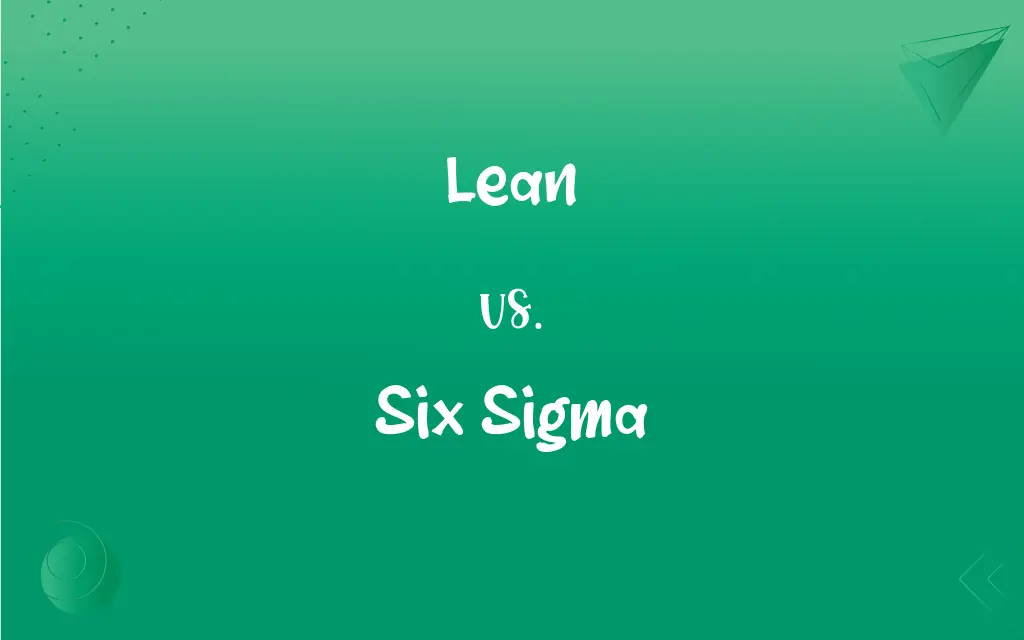Lean vs. Six Sigma: What's the Difference?
Edited by Harlon Moss || By Janet White || Published on February 13, 2024
Lean focuses on minimizing waste and maximizing value in processes, while Six Sigma emphasizes reducing variation and defects for quality improvement.

Key Differences
Lean methodology is centered around the concept of value stream mapping and eliminating waste in every form (like overproduction, excess inventory, and unnecessary transport) to enhance efficiency and value delivery. Six Sigma, conversely, is a data-driven approach that aims to improve quality by identifying and eliminating defects and reducing variability in business processes.
Lean emphasizes creating more value for customers with fewer resources, focusing on continuous flow and just-in-time production. Six Sigma uses statistical tools and techniques to systematically reduce defects and improve process quality, aiming for near-perfection with a target of 3.4 defects per million opportunities.
In Lean, the primary goal is to streamline operations by removing non-value-adding activities, which speeds up processes and reduces costs. Six Sigma focuses more on consistency and predictability in processes, using measures like DMAIC (Define, Measure, Analyze, Improve, Control) to achieve high-quality outcomes.
The Lean approach fosters a culture of continuous improvement and flexibility, encouraging employees to constantly seek ways to improve efficiency. In contrast, Six Sigma often requires more rigorous training and certification, with a structured methodology to solve specific quality issues.
Lean is typically easier to implement and can yield quick results in efficiency and customer satisfaction. Six Sigma, while potentially more time-consuming and complex, offers significant long-term benefits in quality improvement and defect reduction.
ADVERTISEMENT
Comparison Chart
Primary Focus
Minimizing waste, maximizing value
Reducing variation and defects
Approach
Streamlining processes, continuous flow
Data-driven, statistical analysis
Goal
Increase efficiency, reduce costs
Achieve high quality, reduce errors
Implementation
Usually easier, faster results
More complex, requires training
Tools/Techniques
Value stream mapping, JIT production
DMAIC, statistical tools
ADVERTISEMENT
Lean and Six Sigma Definitions
Lean
Lean focuses on eliminating waste in all forms to streamline processes.
The company adopted lean principles to reduce its inventory costs.
Six Sigma
Six Sigma is a quality management approach focusing on reducing process variation.
Six Sigma methodologies helped us achieve near-zero defect rates.
Lean
Lean emphasizes continuous improvement and efficiency in operations.
Implementing lean led to a significant decrease in process downtime.
Six Sigma
A systematic process to improve quality using statistical tools.
Implementing Six Sigma reduced errors in our manufacturing line.
Lean
A system that promotes just-in-time production to reduce waste.
The lean approach minimized our storage needs and handling costs.
Six Sigma
Six Sigma aims for a defect rate of no more than 3.4 per million opportunities.
Achieving Six Sigma level of quality significantly boosted our product reliability.
Lean
A methodology aimed at delivering maximum value with minimal resources.
Lean strategies improved our production cycle and customer satisfaction.
Six Sigma
Focuses on DMAIC methodology for process improvement.
The Six Sigma DMAIC process streamlined our customer service operations.
Lean
Lean drives organizational change towards more efficient workflow.
Adopting lean transformed our company culture to focus on efficiency.
Six Sigma
Six Sigma involves rigorous training and certification for practitioners.
Our team’s Six Sigma certification led to more effective problem-solving strategies.
Lean
To bend or slant away from the vertical.
FAQs
How does Lean improve efficiency?
By removing non-value-adding steps and streamlining workflows.
What statistical tools does Six Sigma use?
Tools like control charts, process mapping, and root cause analysis.
Is Lean easy to implement?
Generally, Lean is more straightforward and faster to implement.
What is the DMAIC process in Six Sigma?
A five-phase process: Define, Measure, Analyze, Improve, Control.
What industries benefit from Six Sigma?
Manufacturing, healthcare, finance, and many others.
Can Lean and Six Sigma be combined?
Yes, they're often integrated for comprehensive process improvement.
What certification is required for Six Sigma?
Belts (Yellow, Green, Black, Master Black) signify different levels of expertise.
What is the main goal of Lean?
To eliminate waste and improve process efficiency.
How does Lean benefit customers?
By delivering higher value products and services more efficiently.
What does Six Sigma focus on?
Reducing process variation and defects for quality improvement.
What role does data play in Six Sigma?
Data is central to identifying, analyzing, and solving quality issues.
What is a Six Sigma Black Belt?
A practitioner with advanced training in Six Sigma methodologies.
What is JIT in Lean?
Just-In-Time production, a strategy to reduce inventory waste.
Can Lean principles be applied to services?
Yes, Lean is applicable to both manufacturing and service industries.
Are Six Sigma projects time-consuming?
They can be, due to their focus on detailed statistical analysis.
What is value stream mapping in Lean?
A tool to visualize and optimize the flow of materials and information.
How does Lean address quality?
By reducing waste and inefficiencies, indirectly improving quality.
How does Lean impact company culture?
It fosters a culture of continuous improvement and efficiency.
Is Six Sigma only for large companies?
No, it can be beneficial for businesses of all sizes.
How do Lean and Six Sigma measure success?
Lean measures success by waste reduction, Six Sigma by quality improvement.
About Author
Written by
Janet WhiteJanet White has been an esteemed writer and blogger for Difference Wiki. Holding a Master's degree in Science and Medical Journalism from the prestigious Boston University, she has consistently demonstrated her expertise and passion for her field. When she's not immersed in her work, Janet relishes her time exercising, delving into a good book, and cherishing moments with friends and family.
Edited by
Harlon MossHarlon is a seasoned quality moderator and accomplished content writer for Difference Wiki. An alumnus of the prestigious University of California, he earned his degree in Computer Science. Leveraging his academic background, Harlon brings a meticulous and informed perspective to his work, ensuring content accuracy and excellence.































































